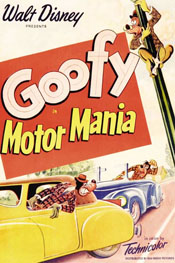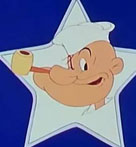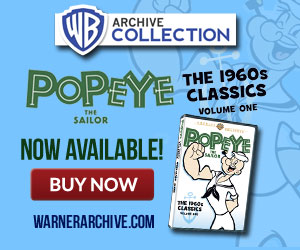
Popeye the Sailor cartoons were a television staple during the 1960’s. Both the theatrical films and the King Features made for television cartoons were airing in hundreds of markets. Children just couldn’t get enough of seeing their favorite spinach eating strongman on television – and, as I discovered, many also had the opportunity to watch him while in the classroom, at churches and in other public service venues.
 The cartoons themselves were produced by several studios, farmed out around the world – New York, Hollywood, Prague, London, etc. – to Oscar winning directors like Gene Deitch and Jack Kinney. The animation in these cartoons is as far away from Disney productions as you can imagine. But were there any connections one could draw between the mighty Disney and these made-for-TV Popeye shorts.
The cartoons themselves were produced by several studios, farmed out around the world – New York, Hollywood, Prague, London, etc. – to Oscar winning directors like Gene Deitch and Jack Kinney. The animation in these cartoons is as far away from Disney productions as you can imagine. But were there any connections one could draw between the mighty Disney and these made-for-TV Popeye shorts.
In the course of my never-ending Popeye research I found one such curious connection: a TV cartoon re-fitted to do double duty – to entertain and to also educate.
In the November 22nd, 1961 edition of Broadcasting Magazine an article was published called, “I’m Popeye the Pubservice Man” (obliviously a play on “public service”).
The piece stated King Features Syndicate is aiming a number of their Popeye television subjects at various public services.
The magazine reported, “for instance, a new Popeye telefilm, titled Uncivil War has Olive Oyl, Wimpy and Brutus demonstrating just about every unsafe driving technique in the books, with dire consequences.”
Uncivil War (1960) was directed by Jack Kinney who was no doubt inspired by his similarly themed Goofy cartoon, Motor Mania (Disney, 1950). For a little more about that short – and other Goofy highway safety cartoons – click here.
The Goofy short was originally shown in theaters – where its safe driving message could reach adults, as well as entertain children. What’s odd is, the King Features Popeye cartoons were strictly aimed at kids.
I guess it didn’t matter. For the most part Kinney’s Popeyes were hit or miss. However, this particular entry was a bit better (in my humble opinion) in both animation quality and story. Click here to see the ‘public service’ version of the cartoon – at 22:37.
The cartoon’s conclusion is a story in itself. Originally, when Swee’pea speeds off on his bike, a Kinney animated Popeye looks at the audience and says, “well ya can’t learns them too young, arf, arf, arf, arf, arf, arf!” This version remained in syndication for years. But it was decided, when screened for public service outlets, the ending would be replaced by Popeye singing a safety song utilizing animation by Paramount Cartoon Studios (who produced several Popeye the Sailor episodes for King Features Syndicate); “Know when ya starts driving, cause safety keeps thriving, says Popeye the Sailor Man, toot! toot!”.
Unfortunately the standard TV version of Uncivil War does away with the song, and dubs Popeye’s voice – “well ya can’t learns them too young, arf, arf, arf, arf, arf, arf” – over the safety song animation. Very bizarre looking to say the least. Take a look:
There are actually three different versions of this cartoon – when this film was dubbed into Italian the cartoon simply ends with Swee’pea zooming off.
A truly unique Popeye television cartoon to say the least!
Thanks to Donald Pitchford (Lum & Abner Cartoonist) and Devon Baxter for their contributions to this article.


 Fred M. Grandinetti is the author of five Popeye related books and a number of articles on the one-eyed sailor. Other topics by Grandinetti published in newspapers, magazines and the web include The original Batwoman (Kathy Kane), I Dream of Jeannie, Tara King (from The Avengers), The Mighty Hercules, the Batman television series and Bozo the Clown. Fred, along with Cuyle Carvin and David Hudon, produced the anti-bullying graphic novel, Different Worlds, Best of Friends. Fred is also the host of the award-winning cable access series, Drawing With Fred.
Fred M. Grandinetti is the author of five Popeye related books and a number of articles on the one-eyed sailor. Other topics by Grandinetti published in newspapers, magazines and the web include The original Batwoman (Kathy Kane), I Dream of Jeannie, Tara King (from The Avengers), The Mighty Hercules, the Batman television series and Bozo the Clown. Fred, along with Cuyle Carvin and David Hudon, produced the anti-bullying graphic novel, Different Worlds, Best of Friends. Fred is also the host of the award-winning cable access series, Drawing With Fred.

























The folks in the Jack Kinney unit seemed to lose interest in the Popeye cartoons after the initial handful were made, preferring to focus their creative energies at the time towards developing The Alvin Show for CBS. The result was lots of weak stories and unfocused efforts — at least in this one, while there’s not much of a story, the segments all are focused on car safety.
(The other thing is, having worked with the character for a quarter-century, the Paramount stock closing animation for Popeye is far more on model than some of the drawings earlier in the cartoon by Kinney and his crew. You’d think having a bunch of ex-Disney animators on board they would have been a little more precise, but that probably goes back to being focused more on Simon, Theodore and Alvin by the time this cartoon was made.)
When I was watching these cartoons on Amazon Prime, I thought this short with its focus on driving seemed a bit unusual for a series of mostly kiddie cartoons. Thank you for the information!
The design of the “alternate ending” is pure Seymour Kneitel: the shape of his eye, the lower lip, the cheek, not looking all that different from the Fleischer cartoons of a quarter century earlier animated by Kneitel. I’ve always wondered if he animated this brief scene (first used in one of the two Popeye TV “pilots” “Hits and Missiles”) himself for auld lang syne.
As for the Jack Kinney Popeyes, the animation, while obviously drastically more limited, isn’t all that different from its theatrical antecedents, especially the ones where Hugh Fraser headed the animation. Anyway, considering the budget and time constraints, it’s not really a fair comparison. And the stories I always tend to defend as having more variety than the Paramount Popeyes, at least utilizing the Thimble Theater characters underused or ignored by Fleischer/Famous: Wimpy, the Jeep, Alice the Goon, Sea Hag, Professor Wottasnozzle (not really a Popeye character, but he appeared in Segar’s “companion” strip “Sappo”), etc.
Kneitel doing animation at that time was almost certainly impossible. However, it’s not unlikely that this was animated by William Henning, who animated for Kneitel for a long time and whose animation style hadn’t changed at all in the decades following his Fleischer work. His work on the KFS Popeyes was also his last credit in animation.
Fascinating! Interesting point that this safe driving message was aimed almost exclusively at kids. A more logical use of the character was the 1971 public service film LOOK WHERE YOU’RE GOING – Popeye introduces and narrates live action footage teaching kids pedestrian safety rules. Although the budget for this one looks pretty meager, there actually is quite a bit of animation in the 15 minute film. Not sure of the production history, Myron Waldman and Jack Mercer are the only names in the credits.
i believe he sings, “so when ya starts driving’, for safety keep strivin’.”
For the good or bad of it, the animation coming from the Knney unit was the most “elaborate” for the budgets compared to the other units. It was more expressive, and less “limited” than what was coming from the Paramount Kneitel unit. This is disappointing considering that this was to original source, using many of the original Animators. It’s unfortunate that they were not as successful in adapting to the technique for television production. Perhaps the only one that overcame the low budgets was the first one they did, HITS AND MISSLES, which was also released theatrically.
I have never heard HITS AND MISSILES was released to theaters before. Did it maybe have different titles? When Paramount released some of their Beetle Baileys, Snuffy Smiths and Krazy Kats, they were repurposed as “Comic King” shorts, but this was in 1962.
Even watching these as a child I sensed the cartoons with the shortened opening theme (Paramount & some of the Gene Deitch
films) were the better cartoons in this series. Paramount allowed Olive to grow as a character who kept The Sea Hag at bay by eating spinach. Even with the limited budget Jack Kinney’s unit turned out a lot of sloppy animated cartoons. Certainly several under his direction were well animated but avoid: Time Marches Backwards, Sea Hagracy, Popeye The Fireman, Timber Toppers, Frozen Feuds, Popeye and The Giant, Popeye the Popular Mechanic, Popeye’s Tea Party, After the Ball Went Over, Camel Aires, Invisible Popeye, Old Salt Tale, Rip Van Popeye, Mississippi Sissy, Double-Cross County Feet Race and Popeye DeLeon,
You know for the KFS tv Popeye Cartoons, in most of the Paramount cartoons, some of the music reminds me of some cues from Casper the Friendly Ghost, I think.